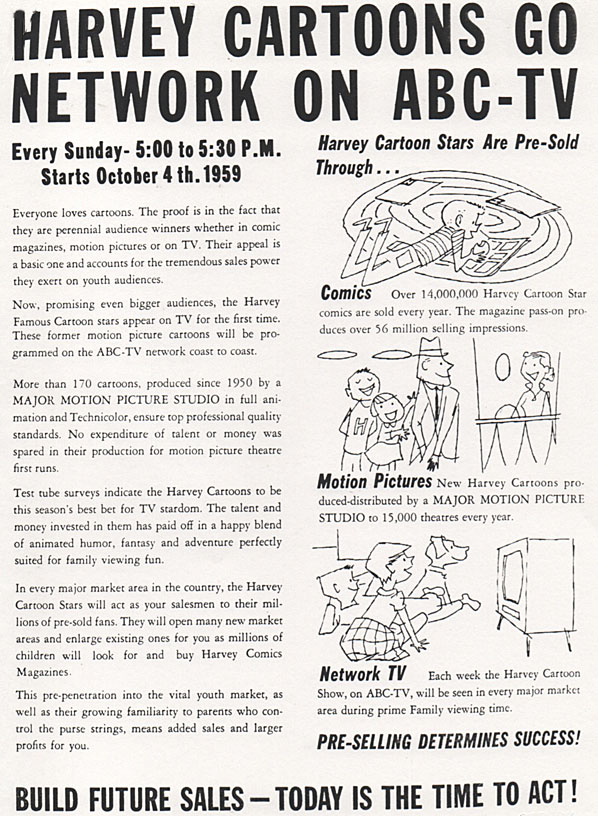
The 1959-60 season was a busy one for the Paramount Cartoon Studio – but not all of the work was for Paramount, nor was it for the big screen.
In October 1959, all the Paramount theatrical cartoons released between September 1950 and 1959 made their debut, sponsored by Mattel Toys, on the ABC Television network. And they were a huge success. Harvey Comics had taken a gamble, and it instantly paid off in comic book sales, and toy merchandising.
Seymour Kneitel and the Paramount Cartoon Studio also profited by success – the studio created openings, bumpers ad commercials to support the series. Here’s a few storyboard panels:
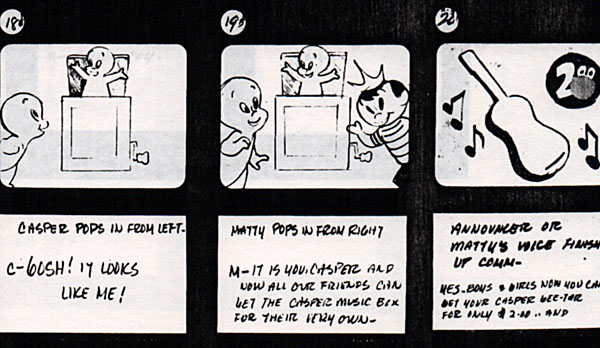
BELOW: Here are some excerpts from the ABC Pressbook which went out to all the local stations to help promote Matty’s Funday Funnies.
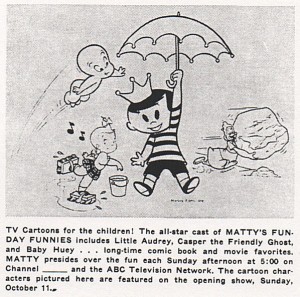

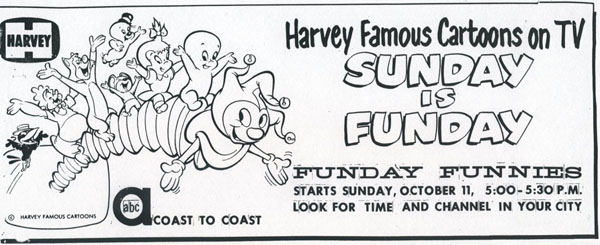
BELOW: Letters from ABC to Alfred Harvey telling of the phenomenal ratings success of Matty’s Funday Funnies. Below that: publicity sheets from Harvey, spreading the word to its comic books dealers and newsstand salesman; and comic books created to exploit the new network show. (click to enlarge)
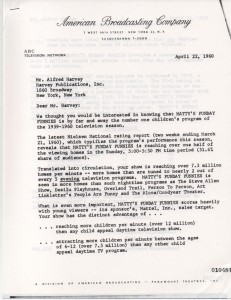


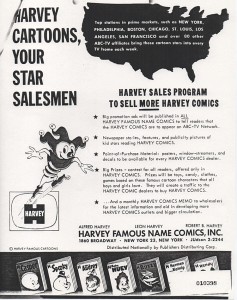

King Features
Popeye may have ended his run as a theatrical cartoon series, but in 1960 Paramount Studio was called upon to be the central hub of new pack of TV cartoons for King Features Syndicate. 220 cartoons were produced (over 60 were produced by Paramount itself, the others farmed out to Gene Deitch, Jack Kinney, Larry Harmon, Halas and Batchelor, and others).

The Theatrical Cartoons
Meanwhile, back in the movie theaters…
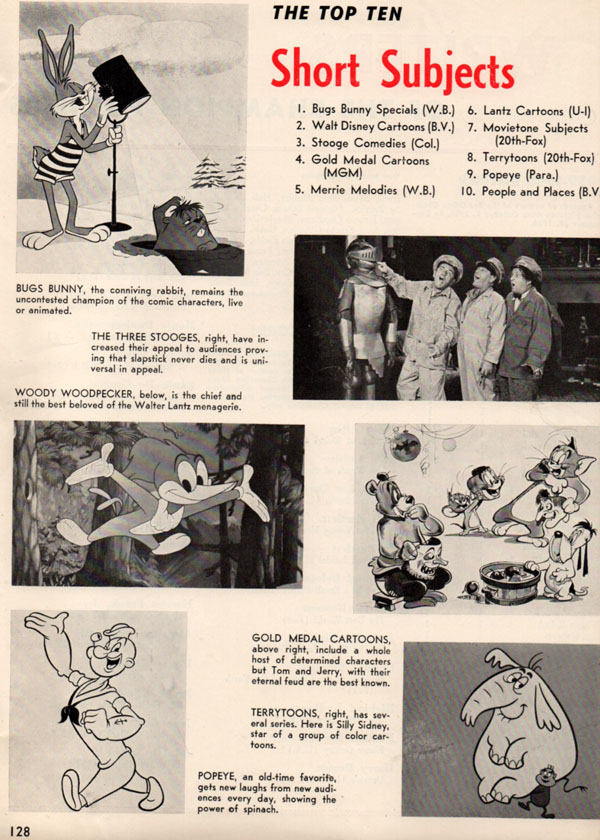
You wouldn’t know from this page out of Motion Picture Herald’s Annual Box Office Champions survey (1959-60) that theatrical shorts were a dying breed. Three of the six pictured were only in reissue. Note that Paramount’s Popeye re-releases still ranked in the top-ten!
With his popularity unabated from constant television exposure, Popeye cartoons (reissues) were still the star attraction of the annual Paramount cartoon line-up being offered to theaters. Paramount’s Cartoon Studio had a firm commitment to supply 20 new theatricals to supplement the Popeye cartoons – but now without the budgets they once enjoyed, nor the recurring characters (Casper, Baby Huey, Herman and Katnip, et al). Doing the best they could with the limited resources they had, Kneitel and his skeleton crew jerry-rigged some old story lines and cobbled together a few new characters that were, unfortunately, met with indifference.
The only variance between the Modern Madcap and Noveltoons at this point, were that the Madcaps tended to feature “human” characters, and the Noveltoons went in for the anthropomorphic.
In the Madcaps, Mike the Masquerader, a disguise-wearing master thief, was an odd choice to star in two rather mediocre cartoons. Another unappealing character, Professor Schmaltz, a bespectacled German “expert”, would also reoccur in this series. In the Noveltoons, Kneitel would recycle several left over Herman and Katnip premises as “Skit and Skat” – Skit the mouse and Skat the cat – two poorly designed characters in three poorly produced cartoons. Nor was losing Tommy Tortoise and Moe Hare going to stop Kneitel from using a left over script with the Tortoise (renamed Mortimer) and the Hare – now entirely redesigned in order to avoid a law suit from Harvey Comics.
A new series was added to the mix – Jeepers and Creepers. This straddled the other two series by starring a pair of anthropomorphic dogs – “Jeepers” an optimistic, free-loading “Bud Abbott-type” and “Creepers” a pessimistic sad sack – in adult-skewing situations (asking the boss for a raise, looking for an old girlfriend, etc.). This didn’t click either; One season and out.
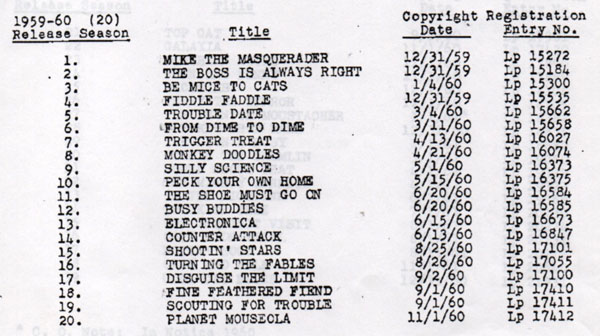
The official list of the 1959-60 season of Paramount cartoons.

The rarely seen original titles for the Jeepers and Creeper series
THE BOSS IS ALWAYS RIGHT (1/15/60) Kneitel/Tafuri. With some help from Jeepers, Creepers (both voiced by Jack Mercer here) tries to get a raise from his boss (Jackson Beck).
TROUBLE DATE (3/11/60) Kneitel/Pattengill. Jeepers help Creepers look for his old girlfriend.
BUSY BUDDIES (6/60) Kneitel/Tafuri. Jeepers enters Creepers into a prize fight to get money to pay his income tax.
SCOUTING FOR TROUBLE (9/60) Kneitel/Tafuri. Jeepers tries to make Creepers look like a hero to his nephew Frisky.
Eight (8) Modern Madcap cartoons
MIKE THE MASQUERADER (1/1/60) Kneitel/Pattengill. An elephant (Sid Raymond) winesses Mike The Masquerader (Gil Mack) robbing a bank and is put in protective custody.
FIDDLE FADDLE (2/26/60) Kneitel/Johnson. Professor Schmaltz sets out to prove that music can sooth the savage beast. NOTE: in flashback, Professor Schmaltz is captured by Choo-Choo’s cannibal tribe!
FROM DIME TO DIME (3/25/60) Kneitel/Johnson. A down on his luck man named Jonah finds a dime on the street, but then gets bit by the Gambling Bug.
TRIGGER TREAT (4/60) Kneitel/Johnson. The new sheriff of an old western town enforces a “No Guns” policy.
THE SHOE MUST GO ON (6/60) Kneitel/Spector. A concert can’t go on unless Luigi the blacksmith stops his pounding.
ELECTRONICA (7/60) Kneitel/Tafuri. Henry buys a robot maid, Electronica, so he won’t have to do anymore housework.
SHOOTIN’ STARS (8/60) Kneitel/Johnson. Two rival TV cowboy stars compete for the right to sign a little boy’s autograph book.
DISGUISE THE LIMIT (9/60) Kneitel/Johnson. Mike The Masquerader tries to steal a diamond dog collar from the neck of Mrs. Von Gotrocks pet poodle.
Eight (8) Noveltoon cartoons
BE MICE TO CATS (2/5/60) featuring Skit and Skat. Scat the Cat is chasing a mouse and his Texas grandfather.
MONKEY DOODLES (4/60) Kneitel/Tafuri. A stork gets confused and delivers a baby gorilla to a human family – and a human baby to a gorilla family.
SILLY SCIENCE (5/60) Kneitel/Klein. Spot gags about Science and future gadgets.
PECK YOUR OWN HOME (5/60) Kneitel/Johnson. Story of a woodpecker who keeps a man from sleeping.
COUNTER ATTACK (7/60) Kneitel/Pattengill. Scat The Cat is chases Skit the mouse through a novelty store.
TURNING THE FABLES (8/60) Kneitel/Spector. A tortoise and a hare are uranium hunters trying to beat each other to the Claims Office.
FINE FEATHERED FIEND (9/60) Kneitel/Johnson. So he can become a brave, an Indian chief’s son goes after an eagle’s feather for his bonnet.
THE PLANET MOUSELOA (10/60) Kneitel/Waldman. Skit the mouse fools Scat the cat into thinking he’s from another planet.
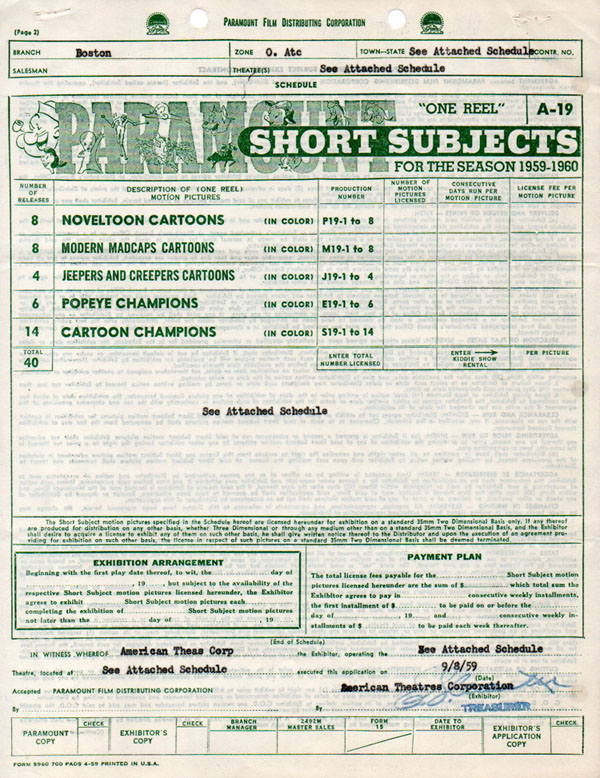
(Thanks to Ken Layton and Paul Spector)
NEXT WEEK: Paramount Cartoons 1960-61



 Jerry Beck is a writer, animation producer, college professor and author of more than 15 books on animation history. He is a former studio exec with Nickelodeon Movies and Disney, and has written for The Hollywood Reporter and Variety. He has curated cartoons for DVD and Blu-ray compilations and has lent his expertise to dozens of bonus documentaries and audio commentaries on such. Beck is currently on the faculty of CalArts in Valencia, UCLA in Westwood and Woodbury University in Burbank – teaching animation history. More about Jerry Beck [
Jerry Beck is a writer, animation producer, college professor and author of more than 15 books on animation history. He is a former studio exec with Nickelodeon Movies and Disney, and has written for The Hollywood Reporter and Variety. He has curated cartoons for DVD and Blu-ray compilations and has lent his expertise to dozens of bonus documentaries and audio commentaries on such. Beck is currently on the faculty of CalArts in Valencia, UCLA in Westwood and Woodbury University in Burbank – teaching animation history. More about Jerry Beck [



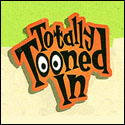



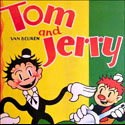
“Cartoon Champions” reissues for the 1959-60 season:
“Better Bait Than Never”
“Surf Bored”
“Huey’s Ducky Daddy”
“The Seapreme Court”
“Crazy Town”
“Hair Today, Gone Tomorrow”
“Cage Fright”
“Pig-a-Boo”
“Frightday the 13th”
“True Boo”
“Northwest Mousie”
“Surf and Sound”
“Of Mice and Menace”
“Ship-a-Hooey”
“Popeye Champions” reissues for the 1959-60 season:
“Let’s Stalk Spinach”
“Punch and Judo”
“Popeye’s Pappy”
“Lunch with a Punch”
“Swimmer Take All”
“Friend or Phony”
Thanks to the HARVEYTOONS SHOW set (that you, Jerry, neatly compiled), I know more than a few of these cartoons, and despite the low budget animation, I rather like ’em. The stories and situations make up for the poor animation. I wish I had the disks of the half hours of HARVEYTOONS SHOW broadcasts that just didn’t make it to airwaves.
On the first of the KFS Popeye cartoons it was animated by The Paramont Cartoom Studios (formally Famous Studios) was a space where Popeye & Olive goes to the Monn where they faced off with King of the Moon who was a abusive tyrant to the citizens of the Moon (who were all cheese and had to pay the king with crackers. The second was Barbecue for Two which had Popeye and Olive (in their original Segar Thimble Theater look even though I don’t know who animated this episode) having a barbecue but were interrupted by Brutus (replacing Bluto) Wimpy and Swee’Pea. By the third Popeye cartoon ( now being produced by Larry Harmon of Bozo the Clown fame) show a “new” Olive Oyl with the face of the Famous Studios version of Olive and the body of the Classic Olive Oyl of the 1930’s
Also the folks who animated King Leonardo had a turn in animating Popeye for one cartoon and the former Famous Studios/Paramount Cartoon Studios animators did the rest of the KFS-Popeye cartoons in the second season.
“Barbecue For Two” was produced and directed by Jack Kinney, with animation by (I think) Format Films, and was the “pilot” for their portion of the Popeye TV package. I seem to recall it did not have any music score except for the Popeye theme lifted from a Paramount theatrical soundtrack. Kinney would employ a composer named Ken Lowman to write original stock themes for the rest of his Popeyes.
Paramount used the Winston Sharples library themes, and Larry Harmon used Gordon Zahler’s General Music Corp. tracks, also heard in his Bozo cartoons and other 60’s series like “The New 3 Stooges.” Anyone know where Gene Deitch got his music?
Keith Scott’s book on Jay Ward states that Ward was approached with, but turned down, the chance to produce series with both David Seville’s Chipmunks and Popeye. I can almost see Ward collaborating with Ross Bagdasarian, Senior; but I can’t even imagine what a Jay Ward Popeye might have been like!
… I can’t even imagine what a Jay Ward Popeye might have been like!
WILLIAM CONRAD: “Be sure to see our next thrilling episode, ‘SWEET POTATO GUY’ or ‘I YAM WHAT I YAM’ !”
A Jay Ward Popeye? Maybe it would look like this:
Wasn’t this also the time some of the Paramount crew were also moonlighting for Joe Oriolo and Hal Seeger?
Didn’t Tom Johnson also pass away suddenly at this time?
Yeah, the blandly-named Mike the Masquerader was an odd character to build one cartoon around, let alone two. And the title of Mike’s second opus, “Disguise the Limit,” was also used for one of the Gene Deitch Popeyes.
Here’s a list of the characters that appeared on the KFS Popeye cartoons who weren’t on the original Paramount cartoon animated by the Fleischer Brothers and Famous Studios but appeared in the Popeye comic strips
Brutus (replacing Bluto)
Alice the Goon
The Sea Hag
King Blotto
The Sea Hag
Thor (The Sea Hag’s henchman)
The Whiffle Bird
And a character exclusive to the KFS Popeye cartoon
Violet Oyl (Olive Oyl’s rambunctious niece.
Also Sweet’Pea now speaks in the KFS Popeye cartoon (voiced by Mae Quetzal)
Don’t forget Rough House the short order cook!
Also Geezil, he and Rough House show up in this particular cartoon that is mostly centered on Wimpy instead (who I have to admit, bit a lot more to do than the one or two times Famous ever used him in previously). Popeye and Olive merely sit on the sidelines as spectators to the whims of Wimpy’s plan.
https://www.youtube.com/watch?v=Cn9Etc_aMNI
I know the KFS Popeye cartoons don’t get a lot of love, but I rather like that they eschew the Famous Studios formula in favor of going back to Segar’s original strips for inspiration. It’s a pity, though, that they didn’t utilize a multi-part narrative format like Ruff & Reddy or Clutch Cargo to really emulate Segar’s storytelling style.
“Wimpy the Moocher” was adapted from one of Segar’s Sunday comic strips.
Two other characters from Segar’s strips who appeared in these TV Popeyes were the Sea Hag’s vulture and Professor O. G. Wottasnozzle.
And another character who was created for these TV cartoons was Roger the talking dog, who was in two of Gene Deitch’s Popeyes.
That was a missed opportunity, especially when Tintin was already getting that treatment with it’s first foray into TV animation.
I don’t recall Violet Oyl being Olive’s niece, but I do remember a tomboyish troublemaker named Diesel Oyl.
I am wondering what Bugs Bunny cartoon that image is referencing?
Some kind of groundhog there?
A gag drawing for publicity use, I’d guess. Bugs, dressed for summer swimming, is making sure the groundhog sees his shadow. But since seeing his shadow means six more weeks of winter, either Bugs has it backwards or he’s just being a jerk.
Having no recurring character to work with really hurt the one-shot stories this season along with the attempts to create new stars — even if they were re-working or reviving old plots for earlier series like Herman & Katnip (or, later, old Casper plots for Goodie the Gremlin), the new characters lacked both the personalities and the animation budgets to put those series over (along with the voice-work — while Jack Mercer continued to be used, outside of the KFS Popeye series, you really don’t hear Mae Questel or Jackson Beck any more after 1960, while Sid Raymond’s voice work also was phased out during the season (Arnold Stang have voiced his last Paramount cartoon the previous season).
We don’t hear much about him today but comedian and writer Eddie Lawrence was involved in several Paramount cartoon projects in the 1960’s, particularly SWIFTY AND SHORTY. His recurring character was The Old Philosopher who was featured on several comedy records of the period. In fact, the S&S kind of play like illustrated comedy records. You can turn off the picture and just listen to the sound and still know what was going on. Check out his section here:
https://en.wikipedia.org/wiki/Eddie_Lawrence
Mae Questel continues to do the voice of Olive Oyl as well as the voice of Swee’Pea, Violet Oyl and The Sea Hag for the KFS Popeye cartoon & Jackson Beck did the voice of Bluto’s “Doppelgänger” Brutus. I wonder who did the voice of Wimpy and the other characters in the KFS Popeye cartoons?
Lawrence will show up in the 1961 release season, which is a step up in terms of quality from the ’60 season’s theatrical releases.
Mercer also does the voice on Wimpy in the KFS Popeyes (which, interestingly, sounds like the voice for Wimpy in the 1935 Fleischer effort “Choose Yorr Weppins”, which was released before Mercer assumed the role of Popeye). He, Beck and Questel also handle most of the incidental voices.
“Shootin’ Stars” was remade that same year as one of their KFS Popeyes – “Autographically Yours”.
https://www.youtube.com/watch?v=CCXRr5wdknU
Paramount certainly was one of the “greenest” cartoon studios (recycle, recycle, recycle).
And again I think the Popeye remake is the better of the two.
Both stories and music (Going thru the list of cartoons, all of which – well, almost all -I’ve seen the last few days on YouTube, knowing Felix the Cat Trans/Lux Oirolo cartoons used music from as late as the Oct.19060 Skit and Skat cartoon Planet Mouselo, and at least ONE 1961, Houndabout That, it pROVES those TV Felixes continued production to 1961 at least. There REALLY needs to be a COMPLETE accurent lsit of the Oriolo Felixes, in order of CORRECT TV debut..
Tom Johnson died in 1960…. There were 10 TVS Popeye cartoons. Lots of the Paramount crew worked for Oriolo and Seeger… Plenty of work in those days.
The new television medium certainly gave these guys plenty to do around NY.
I remember watching the Modern Madcaps with their original Paramount titles along with the Harveytoons here in the Chicago area in the 1970s and early 1980s. They were first on WGN-9 and then moved to WFLD-32 where they remained for many, many years.
The Paramount cartoons released between 1959-62 were televised later on “The New Casper Cartoon Show” in 1963 and had their logos and series titles removed (simply stating they were “Modern Madcaps” regardless whether a particular short was a Modern Madcap originally). while retaining the Paramount copyrights for the titles themselves. The ending could have the show title displayed again with Casper popping out to give the audience an “I’m as confused as you are” gesture! This could be see as a bit lazy on Harvey’s part not to even blot out the copyrights of the titles, but on the bright side, it’s glad those original copyrights exist at all (albeit, reinstated as “Harvey Films” for the “Harveytoons Show” Jerry helped out on).
Was the “Bugs Bunny Specials” a series title given to a new set of reissues, or the “Blue Ribbon” reissues. And did “Loony Tunes” count in the “Merrie Melodies” totals?
Shorn of all the kid-friendly characters they had created, it looks like Paramount tried to get on the trend of more grown-up UPA-style cartoons with human characters. If they only had better execution and some independence, they coulda been a contender.
Was the “Bugs Bunny Specials” a series title given to a new set of reissues, or the “Blue Ribbon” reissues. And did “Loony Tunes” count in the “Merrie Melodies” totals?
For sales purposes, Warner Bros. had long referred to their annual slate of Bugs Bunny cartoons as “Bugs Bunny Specials.” They did this because they sold the Bugs Bunny cartoons as a separate block from the other Looney Tunes and Merrie Melodies. A theater could buy the LT/MM, which were sold as a block, but wasn’t going to get any Bugs Bunny unless they also bought the “Bugs Bunny Specials” block. Why? Greed is nothing new. Warner Bros. knew how popular Bugs was and knew that theaters would gladly pay extra for the privilege of being able to play his cartoons.
The Blue Ribbon reissue series was Warner’s third block of cartoons offered to theaters annually. The first season of Blue Ribbons included a couple of early Bugs Bunny titles, but after that Bugs was excluded from the reissues until the late 1950s. So no getting around it that way. Unless you popped for the “Bugs Bunny Specials,” your theater wasn’t going to be running any Bugs Bunny.
King Features tried to expand on their TV Popeyes with companion series based on Snuffy Smith, Beetle Bailey, and Krazy Kat. Didn’t Paramount have a hand in those too?
There must be a story behind how they chose Krazy, who’d been out of the funnies since George Herriman’s death and was known to boomer kids — if they knew him at all — as the old Mickey Mouse knockoff on local kiddie shows. I know Gene Deitch wrote about his efforts to inject a bit of Herriman into his Krazys.
Eagerly awaiting The Cat.
King Features tried to expand on their TV Popeyes with companion series based on Snuffy Smith, Beetle Bailey, and Krazy Kat. Didn’t Paramount have a hand in those too?
They did, though production of these three separate entities was split between them, Artransa Park Studios in Australia and Bill Snyder’s Rembrandt Films (who did only the Krazy Kat films).
There must be a story behind how they chose Krazy, who’d been out of the funnies since George Herriman’s death and was known to boomer kids — if they knew him at all — as the old Mickey Mouse knockoff on local kiddie shows. I know Gene Deitch wrote about his efforts to inject a bit of Herriman into his Krazys.
His cartoons certainly felt more Herriman than what the others did (Jack Kinney’s studio did at least one too).
Eagerly awaiting The Cat
I’m sure plenty are!
I thought I read somewhere that Deitch was largely responsible for convincing KFS to revive Krazy Kat for the TV cartoons in the first place. Rembrandt Films made most of them, after all. I suspect that KFS may have felt that the cyclical nature of the Pupp-Krazy-Ignatz love triangle might lend itself to some kind of inexpensive cartoon formula but, happily, the stories for the series are a pretty diverse lot.
They certainly went with Herriman-style art and stories, but while Herriman made Krazy sort of gender-ambiguous, Deitch and company went for a more female Krazy.
Columbia/Screen Gems tried to do a Herriman–esque Krazy Kat cartoon, “Li’l Ainjil.”
The Krazy Kat, Beetle Bailey and Snuffy Smith cartoons used west-coast voice talent (Paul Frees could be heard in all three series), in contrast to the NYC- based Popeye cast.
Was there a difference in budget between the TV cartoons that Paramount made and their theatrical cartoons at the time? I barely can tell the difference other than Popeye “sliding” into some scenes.
There really isn’t. The same cheats could be seen often in the theatricals as they were in the TV efforts. The studio already had a lot on their plate when it came to their efforts during the early 60’s with balancing between the theatricals and television projects.
In the Jeepers and Creepers series, Creepers had three different voices. Jack Mercer did his voice in “Scouting For Trouble”; I am guessing Allen Swift voices him in “Trouble Date” and “The Boss Is Always Right” while Syd Raymond is the voice in “Busy Buddies.” (Don’t hesitate to tell me if I’m wrong—and I usually am.) 😉